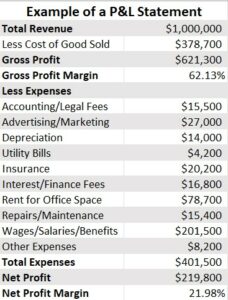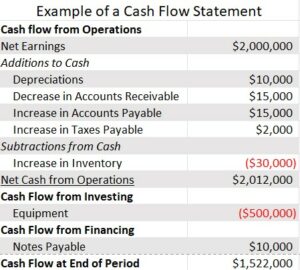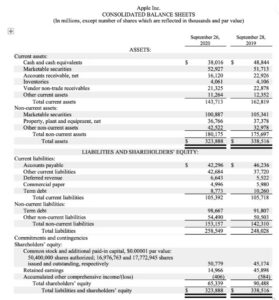Starting a business means taking in massive amounts of information in a short period, analyzing it, and then making essential decisions that impact the health of your business. Even when you have prepared your product lines to meet the needs of your customers and can easily sell your services, you might not be familiar with all the administrative tasks that go on behind the scenes, which are just as critical to your long-term success.
One of the most common areas where business owners struggle is understanding their financial statements. As the owner, you might be struggling to understand what they mean. If you try to read them, you might come away scratching your head and wondering whether you have the capital available to invest in your infrastructure or to expand your team. Let’s dive into the 4 basic financial statements, including what they are, how to read them, and examples of these statements based upon generally recognized accounting principles.

What Are the 4 Basic Financial Statements?
1. Profit and Loss Statement (P & L Statement, Income Statement)
A profit and loss statement or income statement is a report providing a summary of your revenue, expenses, and profits/losses over a specific time frame. It demonstrates what your business is able to generate in terms of sales, how it manages expenses, and whether your business is profitable. Your P&L statement is based on accounting principles, including accruals, revenue recognition, and matching, which makes it different from the information available on your cash flow statement. The main categories found on your P&L statement are:
- Revenue
- Cost of sales
- Selling, general, and administrative expenses
- Marketing
- Technology/R&D
- Interest expenses
- Taxes
- Net income
2. Cash Flow Statement
A cash flow statement is a summary of the movement of cash and cash equivalents through your business. It measures how well you manage your cash, including how well you generate cash to pay your bills and fund your operating expenses. The main components include cash from operating, financing, and investing activities. There are two methods for calculating your cash flow, either the direct or indirect method. Potential investors can use your cash flow statement to determine whether your business is on solid financial ground.
3. Balance Sheet
A balance sheet reports your business assets, liabilities, and any shareholder equity at a specific time point. Investors use balance sheets to compute the rates of return and the capital structure of your business. It provides a snapshot of what you owe and what you own, plus anything invested by your shareholders. Combined with the other financial statements, you can conduct financial analysis or calculate various financial ratios.
4. Statement of Retained Earnings
Retained earnings are the profits left after your business paid any dividends to your shareholders or stockholders. Any surplus after this step would be the company’s retained earnings. Your statement of retained earnings could be part of your balance sheet or a separate financial statement. Retained earnings can be redirected into multiple areas of your business, including:
- Debt repayment
- Growth investments
- Stock buybacks
- Creating new products or expanding services
- Mergers
Each financial statement provides a different aspect of your financial position, giving you a different perspective on your financial health. How can you read them effectively to understand the financial health of your business?
How Do You Read Each Of Them?
1. Profit and Loss Statement (P & L Statement, Income Statement)
There are 7 steps necessary to read your P&L statement, which include the following:
- Define the revenue – Revenue details income from sales and activity for the reporting period.
- Understand the expenses – Operating expenses include all the costs associated with running your business. Direct costs are how much you spend to create your products for sale.
- Calculate your gross margin – Direct costs are subtracted from revenue, showing how much you have for operating expenses.
- Calculate operating income – Your adjusted revenue after accounting for your operating expenses and any depreciation. Determine operating income by subtracting your operating expenses from your gross margin.
- Budget versus actual – This allows you to see how your company is performing against its original budget projections. With this information, you can determine if your business is meeting or exceeding expectations in terms of revenue and expenses.
- Year over year – You can use P&L statements to compare specific seasons or time periods to determine whether your earnings are in line with previous years or not.
- Determine net profit – By taking your operating income and subtracting taxes, debt interest, depreciation, and amortization, you can determine your income related to the expense of operating your business. Net profit can be negative, even if you have positive cash flow, because your company currently holds a significant amount of debt.
Working with your bookkeeper or accountant, you can find all these numbers on your P&L statement, thus getting a clearer idea of the overall financial health of your business.

2. Cash Flow Statement
Your cash flow statement shows the money entering and leaving your company during a specific period of time. To read it properly, you need to know the three categories represented:
- Operating activities – Cash from the core business operations, such as purchases, payroll, and sales.
- Investing activities – Cash from buying or selling long-term assets, such as property, securities, or equipment.
- Financing activities – Cash from borrowing or repaying loans, buying back or issuing new shares, and paying dividends to your shareholders.
The cash statement begins with your beginning cash balance and your ending cash balance, much like your bank statement. Cash flowing into the business is depicted with positive values, and cash flowing out of the business is represented by negative values.
3. Balance Sheet
Your balance sheet provides a list of your assets, liabilities, and shareholder equity at a given point in time. You can use this information to compute rates of return but also to evaluate the capital structure of your business, as well as identify specific trends across periods. Reading your balance sheet includes:
Understanding your current assets
- Accounts receivable – amounts owed to your business
- Inventory – finished goods, products in production, and raw materials
- Cash – petty cash on hand and balances in your bank accounts
- Prepaid expenses – goods or services paid for in advance
Analyze non-current assets
- Tangible assets – real estate, machinery, and equipment are known as fixed assets.
- Intangible assets – aren’t physical and could be goodwill, copyrights, or patents
Examine liabilities
- Current liabilities – Short-term liabilities to be paid within the next year, such as accounts payable, payroll, taxes, and current payments toward any long-term debts
- Long-term liabilities – debts, loans, and financial obligations due in more than a year, such as lines of credit or mortgages
Understanding owner’s equity/shareholders’ equity
As an entrepreneur, it is critical that you know the net worth of your business, including the initial sum invested by owners or shareholders. If you reinvest net earnings or pay out dividends at the end of the year, then retained earnings after those dividends are paid out are reported here.

4. Statement of Retained Earnings
Start by looking at the beginning balance to know what your company started out this period with. Next, look at the current period’s net income or net loss to see how much was earned or lost. Finally, look at the dividends paid to determine how much was paid to the shareholders.
By subtracting your dividends from the net income, then you can see how much profit was reinvested into the company to support its long-term growth.
Now that you know what to look for on each of these financial statements, let’s look at some examples to see how to put these steps into practice as you analyze your company’s financial health.
Examples of Each Basic Financial Statement
1. Profit and Loss Statement (P & L Statement, Income Statement)

This is a straight forward method of showing your revenue, expenses, and net profit margin.
2. Cash Flow Statement

This illustrates where cash was spent and the current cash flow available.
3. Balance Sheet

This example of a balance sheet shows the financial position of Apple, Inc. over two years, allowing for comparison.
4. Statement of Retained Earnings

This example shows how retained earnings are reported year after year.
5 Tips for Entrepreneurs Reading Financial Statements
Here are 5 tips to assist you as you read through your company’s financial statements in the next quarter:
- Be willing to ask questions
- Keep your financials up to date
- Are your expenses in line with your industry? Too high could mean not enough available cash, and too low could mean your business isn’t growing.
- Are your income numbers reflecting your sales, or are your accounts receivable high? It could be a sign that your cash flow is in jeopardy.
- The ratio of debt to income – Have you overextended your business, or is your ratio of debt in line with your sales and other expenses?
You can learn a lot about how your business operates by analyzing your financial statements and the data they provide. As an entrepreneur, this can help you to build a thriving business, ready for sale, as part of your exit strategy.
What Is AccountsBalance?
AccountsBalance is a monthly bookkeeping service specialized for agencies & SAAS companies.
We take monthly bookkeeping off your plate and deliver your financial statements by the 15th or 20th of each month. You’ll have your Profit and Loss Statement, Balance Sheet, and Cash Flow Statement ready for analysis each month so you and your business partners can make better business decisions.
In Summary
As an entrepreneur, you have plenty of balls in the air. Working with your bookkeeper or accountant, you can successfully read your financial statements, thus putting yourself in the best position to make financial choices that benefit your company. No matter where your business is headed, as an entrepreneur, your success or failure can be found in the financial statements.









